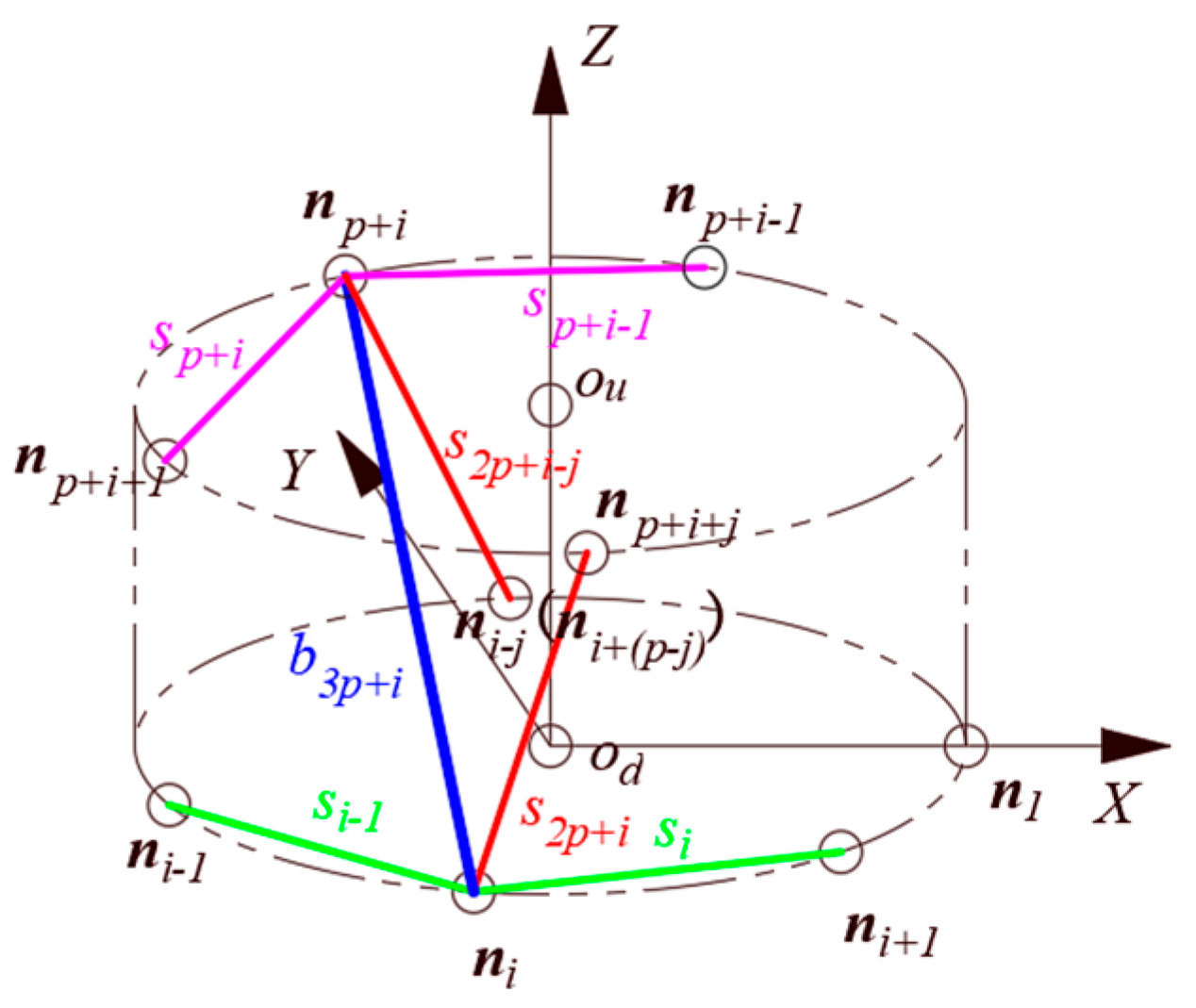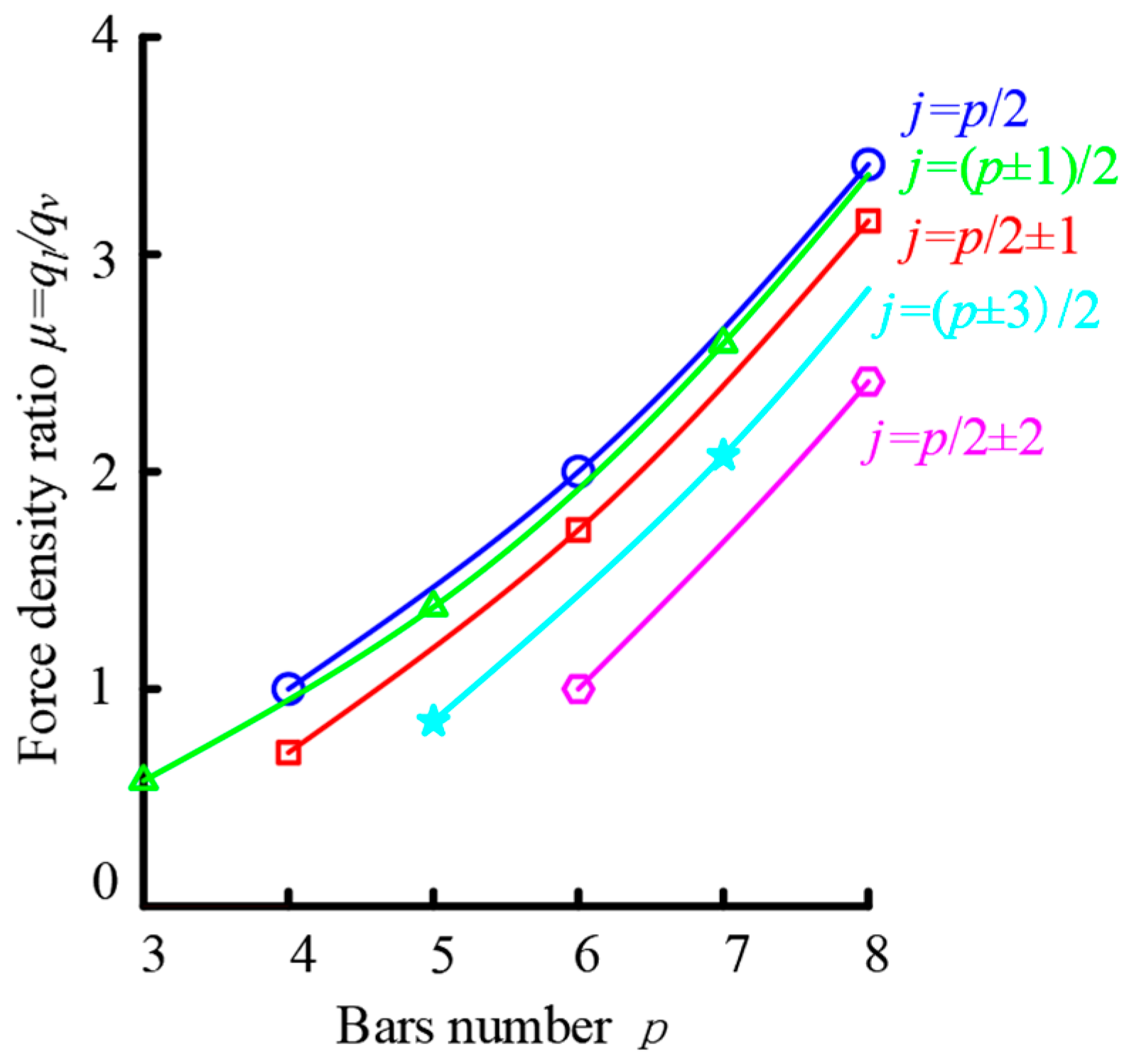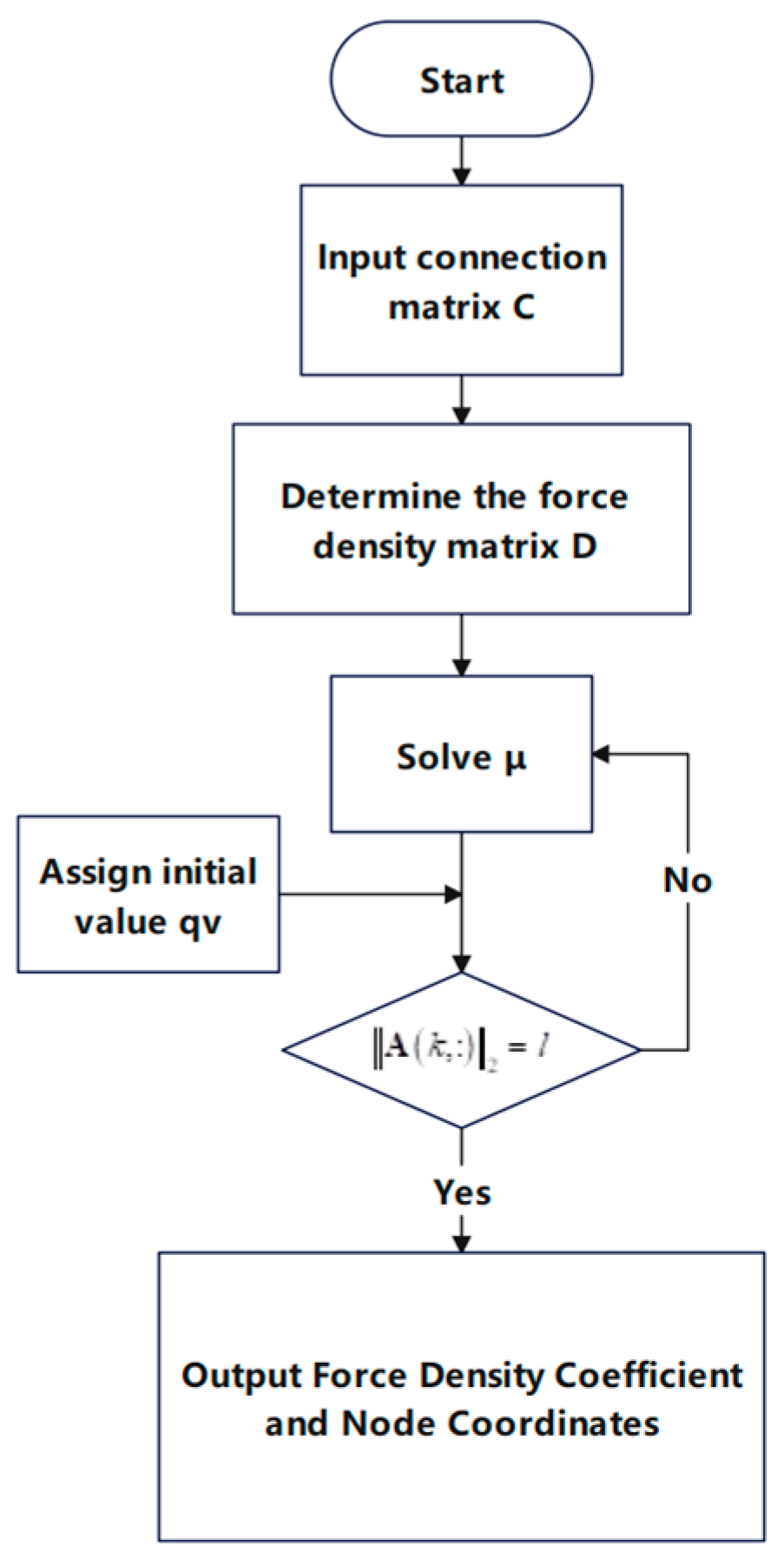Form-Finding of Tensegrity Basic Unit with Equal Cable Length
Abstract
:1. Introduction
2. Balance Analysis of Tensegrity Basic Unit with Equal Cable Length
2.1. The Basic Assumptions of the Force Density Method
- The geometric topology of the structure is understood;
- The connections between each component are assumed to be frictionless hinges;
- The self-weight of the structure is not taken into account, and no external load is applied;
- Buckling of the bars is not considered; only axial tension and compression are transmitted between components;
- Dissipation and the effects of forces on the structure are not taken into account;
- The force density of each member always remains constant.
2.2. Representation of the Balance of Tensegrity Structures
2.3. Determining Additional Conditions for Stable Configuration of a Tensegrity Basic Unit with Equal Cable Length
3. The Force Density Characteristic Analysis of Tensegrity Basic Unit with Equal Cable Length
3.1. The Ode Coordinates of Tensegrity Basic Unit with Equal Cable Length
3.2. The Force Density Attribute of Tensegrity Basic Unit with Equal Cable Length
3.3. The Force Density Matrix Attribute of Tensegrity Basic Unit with Equal Cable Length
4. The Form-Finding of Tensegrity Basic Units with Equal Cable Length
4.1. Characteristic Polynomials of the Force Density Matrix of Tensegrity Structures
4.2. Stability Conditions of Tensegrity Structures
4.2.1. Stable Configuration Conditions for Planar Structures
4.2.2. Stable Configuration Conditions for Spatial Structures
4.3. Stability Conditions of Tensegrity Structures with Equal Cable Length
- ;
- The end surface node coordinates equally divide the respective end surface circumscribed circles (X direction and Y direction);
- ;
- , .
- The form-finding process involves the following:
- Determining the connection matrix and force density matrix of the structure;
- Solving the force density coefficient using Equation (37) and numbering them sequentially;
- Substituting a force density coefficient into Equation (12) to solve the node coordinate matrix and checking if Equation (16) is satisfied. If not, the process repeats by changing the force density coefficient value. If all values are tried and Equation (16) is still not satisfied, the program concludes with a “no solution” output;
- If Equation (16) is satisfied, the force density coefficient and node coordinates are output, and the program ends.
5. Examples
5.1. Form-Finding of Planar Structure
5.2. Form-Finding of Spatial Structure
6. Conclusions
- This paper introduces the primary and auxiliary fractal parameters by applying node force balance theory and examining the stable configuration conditions of the tensegrity basic unit with equal cable lengths. Consequently, the force density coefficient ratios for the end surface horizontal cables, stayed cables, and bars can be derived.
- The expression for the force density matrix is derived by applying the force balance equation to the stable configuration. The ratio of the force density coefficients is determined by analyzing the rank deficiency of the force density matrix. This rank deficiency can be interpreted as a condition whereby the partition coefficient of the force density polynomial is equal to zero. The coefficients of the force density polynomial can be calculated by evaluating the determinant of a matrix formed by the trace of the powers of the force density. Ultimately, the theoretical ratio of the density coefficients is established by setting the determinant to zero.
Author Contributions
Funding
Data Availability Statement
Conflicts of Interest
References
- Motro, R. Tensegrity: Structural Systems for the Future; Elsevier: Amsterdam, The Netherlands, 2003. [Google Scholar]
- Richard, B.F. Tensile-Integrity Structures. U.S. Patent Application No. US3063521A, 13 November 1962. [Google Scholar]
- Zhang, J.; Ohsaki, M. Tensegrity Structures; Springer: Berlin/Heidelberg, Germany, 2015; Volume 7. [Google Scholar]
- Deng, H. Analysis of Cable-Bar Assemblies: Theories and Methods; Science Press: Beijing, China, 2018. [Google Scholar]
- Chen, W. Theoretical Method and Engineering Application of Cable-Strut Tension Structure Design and Analysis; Science Press: Beijing, China, 2021. [Google Scholar]
- Luo, Y. Morphology of Spatial Structure; Science Press: Beijing, China, 2022. [Google Scholar]
- Xu, X. Morphological Design and Control of Tensegrity Structure; Science Press: Beijing, China, 2017. [Google Scholar]
- Xue, Y.; Luo, Y.; Xu, X. Form-finding of cable-strut structures with given cable forces and strut lengths. Mech. Res. Commun. 2020, 106, 103530. [Google Scholar] [CrossRef]
- Wang, Y.; Xu, X.; Luo, Y. A unifying framework for form-finding and topology-finding of tensegrity structures. Comput. Struct. 2021, 247, 106486. [Google Scholar] [CrossRef]
- Wang, Y.; Xu, X.; Luo, Y. Topology Design of General Tensegrity with Rigid Bodies. Int. J. Solids Struct. 2020, 202, 278–298. [Google Scholar] [CrossRef]
- Xu, X.; Huang, S.; Wang, Y.; Luo, Y. A generalized objective function based on weight coefficient for topology-finding of tensegrity structures. Appl. Math. Model. 2023, 115, 541–567. [Google Scholar] [CrossRef]
- Koohestani, K. On the analytical form-finding of tensegrities. Compos. Struct. 2017, 166, 114–119. [Google Scholar] [CrossRef]
- Xu, X.; Wang, Y.; Luo, Y. Finding member connectivities and nodal positions of tensegrity structures based on force density method and mixed integer nonlinear programming. Eng. Struct. 2018, 166, 240–250. [Google Scholar] [CrossRef]
- Miki, M.; Kawaguchi, K. Extended force density method for form-finding of tension structures. J. Int. Assoc Shell Sp. 2010, 51, 291–303. [Google Scholar]
- Ohsaki, M.; Zhang, J. Nonlinear programming approach to form-finding and folding analysis of tensegrity structures using fictitious material properties. Int. J. Solids Struct. 2015, 69–70, 1–10. [Google Scholar] [CrossRef]
- Miki, M.; Kawaguchi, K. Three-term method and dual estimate: Form finding problems of tension structures and large deformation problems of continuum bodies. J. Stage 2012, 77, 611–618. [Google Scholar]
- Masic, M.; Skelton, R.E.; Gill, P.E. Algebraic tensegrity form-finding. Int. J. Solids Struct. 2005, 42, 4833–4858. [Google Scholar] [CrossRef]
- Zhang, H.; Shan, J. Initial form finding and free vibration properties study of membrane. In Proceedings of the Xi’an International Conference of Architecture and Technology, Proceedings-Architecture in Harmony, Xi’an, China, 23–25 September 2006; p. 316. [Google Scholar]
- Xu, X.; Yu, Y.; Luo, Y.; Shen, Y. Tensegrity Form-Finding Using Finite Particle Method. Adv. Mater. Res. 2011, 201, 1166. [Google Scholar] [CrossRef]
- Collins, M.; Cosgrove, T. Dynamic relaxation modelling of braced bending active gridshells with rectangular sections. Eng. Struct. 2019, 187, 16–24. [Google Scholar] [CrossRef]
- Ye, J.; Feng, R.; Zhou, S. The Modified Dynamic Relaxation Method for the Form-Finding of Membrane Structures. Adv. Sci. Lett. 2011, 4, 2845–2853. [Google Scholar] [CrossRef]
- Kabasi, S.; Marbaniang, A.L.; Ghosh, S. Form-finding of frame-supported non-minimal tensile membrane structures for anisotropic prestress using physics-informed neural networks. Struct. Multidiscip. Optim. 2024, 67, 56. [Google Scholar] [CrossRef]
- Miki, M. Structural and Geometric Applications of the Geodesic Dynamic Relaxation Method. In Proceedings of the Textiles Composites and Inflatable Structures VII: Proceedings of the VII International Conference on Textile Composites and Inflatable Structures, Barcelona, Spain, 19–21 October 2015; pp. 26–33. [Google Scholar]
- Wang, X.; Cai, J.; Yang, R.; Feng, J. Form-finding of deployable mesh reflectors using dynamic relaxation method. ACTA Astronaut. 2018, 151, 380–388. [Google Scholar] [CrossRef]
- Ali, N.B.H.; Rhode-Barbarigos, L.; Smith, I.F. Analysis of clustered tensegrity structures using a modified dynamic relaxation algorithm. Int. J. Solids Struct. 2011, 48, 637–647. [Google Scholar]
- Schek, H.O.R. The force density method for form finding and computation of general networks. Comput. Methods Appl. Mech. Eng. 1974, 3, 115–134. [Google Scholar] [CrossRef]
- Zhang, J.Y.; Ohsaki, M. Adaptive force density method for form-finding problem of tensegrity structures. Int. J. Solids Struct. 2006, 43, 5658–5673. [Google Scholar] [CrossRef]
- Heng, T.; Zhao, L.; Liu, K.; Yi, J.; Duan, X.; Sun, Z. An Improved Form-Finding Method for Calculating Force Density with Group Theory. In Proceedings of the 2021 11th International Conference on Intelligent Control and Information Processing (ICICIP), Dali, China, 3–7 December 2021; pp. 119–124. [Google Scholar]
- Zhang, L.; Zhu, S.; Li, S.; Xu, G. Analytical form-finding of tensegrities using determinant of force-density matrix. Compos. Struct. 2018, 189, 87–98. [Google Scholar] [CrossRef]
- Cai, J.; Wang, X.; Deng, X.; Feng, J. Form-finding method for multi-mode tensegrity structures using extended force density method by grouping elements. Compos. Struct. 2018, 187, 1–9. [Google Scholar] [CrossRef]
- Wang, Y.; Xu, X.; Luo, Y. Form-finding of tensegrity structures via rank minimization of force density matrix. Eng. Struct. 2021, 227, 111419. [Google Scholar] [CrossRef]
- Shang, R.; Zhao, Y.; Yin, Z. Geometric Drawing Method for Form-finding and Force-finding to Triangular Prism Tensegrity with End Surfaces not Paralleled. J. Phys. Conf. Ser. 2020, 1624, 052012. [Google Scholar] [CrossRef]
- Chen, Y.; Sun, Q.; Feng, J. Improved Form-Finding of Tensegrity Structures Using Blocks of Symmetry-Adapted Force Density Matrix. J. Struct. Eng. 2018, 144, 04018174. [Google Scholar] [CrossRef]
- Koohestani, K.; Guest, S. A new approach to the analytical and numerical form-finding of tensegrity structures. Int. J. Solids Struct. 2013, 50, 2995–3007. [Google Scholar] [CrossRef]
- Koohestani, K. Form-finding of tensegrity structures via genetic algorithm. Int. J. Solids Struct. 2012, 49, 739–747. [Google Scholar] [CrossRef]
- Tran, H.C.; Lee, J. Advanced form-finding of tensegrity structures. Comput. Struct. 2010, 88, 237–246. [Google Scholar] [CrossRef]
- Lee, S.; Lee, J. Form-finding of tensegrity structures with arbitrary strut and cable members. Int. J. Mech. Sci. 2014, 85, 55–62. [Google Scholar] [CrossRef]
- Zhao, L.; Heng, T.; Liu, K.; Sun, Z. A zeroing neural network model for form-finding problems: A nonlinear optimization approach. Eng. Appl. Artif. Intell. 2024, 128, 107492. [Google Scholar] [CrossRef]
- Hernández, L.; Fernández-Ruiz, M.A.; Gil-Martín, L.M. Influence of the level of connectivity on the members of the Octahedron and X-Octahedron families of tensegrities. Eng. Struct. 2023, 296, 116927. [Google Scholar] [CrossRef]
- Jiang, J.; Yin, X.; Xu, G.; Wang, Z.; Zhang, L. A unified analytical form-finding of truncated regular octahedral tensegrities. Int. J. Mech. Sci. 2023, 239, 107857. [Google Scholar] [CrossRef]
- Cao, Z.; Luo, A.; Feng, Y.; Liu, H. Self-Equilibrium Analysis and Minimal Mass Design of Tensegrity Prism Units. J. Appl. Mech. 2024, 91, 071007. [Google Scholar] [CrossRef]
- Liu, H.; Sanaullah; Vumiliya, A.; Luo, A. A resource-efficient form-finding approach to tensegrity structures. Eng. Comput. 2024, 41, 1–17. [Google Scholar] [CrossRef]
- Wang, H.; Huang, Z.; Yi, J.; Jiang, W.; He, Z. Static Analysis on Some Typical Tensegrities with Additional Cables. J. Eng. Mech. 2022, 148, 04021162. [Google Scholar] [CrossRef]
- Zhang, L.; Li, Y.; Cao, Y.; Feng, X. Stiffness matrix based form-finding method of tensegrity structures. Eng. Struct. 2014, 58, 36–48. [Google Scholar] [CrossRef]
- Juan, S.H.; Tur, J.M.M. Tensegrity frameworks: Static analysis review. Mech. Mach. Theory 2008, 43, 859–881. [Google Scholar] [CrossRef]
- Rhode-Barbarigos, L.; Ali, N.B.H.; Motro, R.; Smith, I.F. Designing tensegrity modules for pedestrian bridges. Eng. Struct. 2010, 32, 1158–1167. [Google Scholar] [CrossRef]
- Vassart, N.; Motro, R. Multiparametered form finding method: Application to tensegrity systems. Int. J. Space Struct. 1999, 14, 147–154. [Google Scholar] [CrossRef]
- Kuhl, D.; Lim, Y.C.; Long, D.S. Tensegrity Structures—Computational and Experimental Tensegrity Mechanics. AIP Conf. Proc. 2017, 1863, 410005. [Google Scholar]
- Kleppner, D.; Kolenkow, R. An Introduction to Mechanics, 2nd ed.; Cambridge University Press: La Vergne, TN, USA, 2012. [Google Scholar]
- Hibbeler, R.C. Engineering Mechanics: Statics, Twelfth Edition—Instructor's Solutions Manual; Pearson Education: London, UK, 2010. [Google Scholar]
- Song, K.; Scarpa, F.; Schenk, M. Form-finding of tessellated tensegrity structures. Eng. Struct. 2022, 252, 113627. [Google Scholar] [CrossRef]
- Cao, Z.; Luo, A.; Liu, H.; Feng, Y. A novel torque application method for tensegrity structures. Mech. Based Des. Struct. Mach. 2024. [Google Scholar] [CrossRef]
- Liu, H.; Luo, A. Structure and Splicing of Tensegrity Unit; Harbin Engineering University Press: Harbin, China, 2019. [Google Scholar]
- Pytel, A.; Kiusalaas, J. Engineering Mechanics: Statics, 3rd ed.; Cengage Learning: Stamford, CT, USA, 2010; Volume 1. [Google Scholar]
- Zhao, Y.; Luo, A. Attribute analysis of tensegrity basic unit for equal cable length. In Proceedings of the 31st National Conference on Structural Engineering (No. 1), Press of Engineering Mechanics, Nanning, China, 5–8 October 2022; pp. 211–214. [Google Scholar] [CrossRef]
- Van Kortryk, T.S. Matrix exponentials, SU(N) group elements, and real polynomial roots. J. Math. Phys. 2016, 57, 021701. [Google Scholar] [CrossRef]
- Curtright, T.L.; Zachos, C.K. Elementary Results for the Fundamental Representation of SU(3). Rep. Math. Phys. 2015, 76, 401–404. [Google Scholar] [CrossRef]
- Curtright, T.L.; Fairlie, D.B.; Alshal, H. A Galileon Primer. arXiv 2020, arXiv:1212.6972. [Google Scholar]







| Bars | 3 | 4 | 5 | 6 | |
|---|---|---|---|---|---|
| Force density coefficient rations | - | 1 | - | 2 | |
| 0.577 | - | 1.376 | - | ||
| - | 0.707 | - | 1.732 | ||
| - | - | 0.851 | - | ||
| - | - | - | 1 |
Disclaimer/Publisher’s Note: The statements, opinions and data contained in all publications are solely those of the individual author(s) and contributor(s) and not of MDPI and/or the editor(s). MDPI and/or the editor(s) disclaim responsibility for any injury to people or property resulting from any ideas, methods, instructions or products referred to in the content. |
© 2024 by the authors. Licensee MDPI, Basel, Switzerland. This article is an open access article distributed under the terms and conditions of the Creative Commons Attribution (CC BY) license (https://creativecommons.org/licenses/by/4.0/).
Share and Cite
Zhao, Y.; Luo, A.; Liu, H. Form-Finding of Tensegrity Basic Unit with Equal Cable Length. Aerospace 2024, 11, 782. https://doi.org/10.3390/aerospace11090782
Zhao Y, Luo A, Liu H. Form-Finding of Tensegrity Basic Unit with Equal Cable Length. Aerospace. 2024; 11(9):782. https://doi.org/10.3390/aerospace11090782
Chicago/Turabian StyleZhao, Yingyu, Ani Luo, and Heping Liu. 2024. "Form-Finding of Tensegrity Basic Unit with Equal Cable Length" Aerospace 11, no. 9: 782. https://doi.org/10.3390/aerospace11090782





